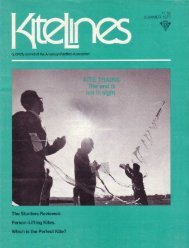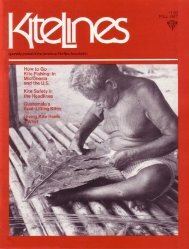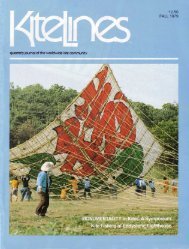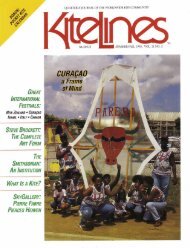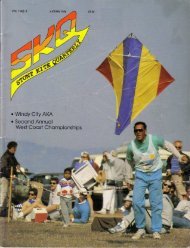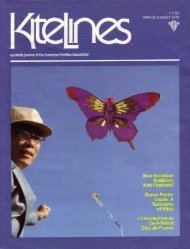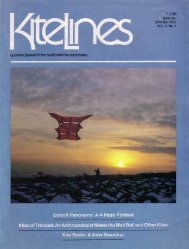Untitled - KiteLife
Untitled - KiteLife
Untitled - KiteLife
- No tags were found...
Create successful ePaper yourself
Turn your PDF publications into a flip-book with our unique Google optimized e-Paper software.
side toward the nose (up) untilthe problem is corrected .- The kite will not gain altitude .- The bridle clips are adjustedtoo low - set the bridle lighter(up) .- The kite does not respond or issluggish to the controls .- The bridle is adjusted too high -set the bridle heavier (down)- The flying lines may have toomany twists .- The existing wind may be toolight- The kite tends to soar directlyoverhead, then nosedives .- The bridle is adjusted too high -set the bridle heavier (down)TROUBLESHOOTING FOR TRAINS OFKITES .(Basic bridle settings suggested bymanufacturers for trains of kitesare higher than for a single kite -read manufacturer's instructionscarefully.)- The last kites in a train flair out(lag behind the rest of the kites)when doing loops .The bridle setting is too high -set heavier (down)- Several of the kites in the traintend to fly out of line, fly faster orlag behind the rest .- Check that all the train linesare exactly the same length .- The flying lines or bridles breakwhen flying a train .- Bridle setting is too heavy - setlighter (up)- Bridle lines are too light -rebridle with stronger line .- You may be flying too manykites for the existing wind conditions.(NOTE: Common senseis advised BEFORE you launcha large stack of kites in heavywinds . Can you handle them?)HIGH WIND MODIFICATIONS- In high winds (30 mph plus) thetop reinforcement stretches allowingthe spreader to slidedown, causing a change inflight control .- Push the vinyls back to theiroriginal position and glue aseparate piece of vinyl tubingonto the leading edge rod .(outer front side strut) just under the sliding vinyl . Use any'vinyl about 5/16"x1/4" long . Slitthe vinyl so that it will snaponto the leading edge rod .Glue the vinyl (e .g . Super Glueor epoxy) so that the tophorizontal spreader will notslide rearward under pressure .- A simple way to reinforce thespars for heavy winds is to findanother (smaller) spar that will fitinside the stock spar or substitutea solid fiberglass rod for the hollowone . (This will also increasethe weight of the kite. Rememberto remove it when the windsare lighter.)- At a certain high wind speed(Which will vary with each makeof kite) all winged type stuntkites leading edge rods (outerfront side struts) will begin tobend or flap in the wind . This isan indication that you are flyingin a wind that is stronger thancan be handled by the kitedesign. No modifications canresolve this problem . You shouldstop flying before the kite isseriously damaged .LIGHT WIND MODIFICATIONS- Generally the lighter the kite thelighter the winds it will fly in . Youcan replace the spars on thekite with lighter spars, to increaselight wind performance .- Fly the kite on the lightest flyingline you can . (Drag of the flyingline is VERY critical on light windkite performance .)- Ultimately the ability of the flier isthe critical factor in light windstunt kite flying . An experiencedflier can (generally) fly in lighterwinds than can a beginner .- In light winds the kite must keepmoving in order to fly . Backingup will help, but you will soonrun out of safe flying field .Never "lose" field unless ab--solutely necessary .- Keep the kite moving horizontally(from side to side) this iscalled rowing . When youmake the outside turns, alwaysturn up . Never lose altitude un--less absolutely necessary .- To gain field space in lightwinds, pull back on the lines ortake several steps back toforce the kite to climb . Whenyou then dive the kite, movequickly forward, gaining field .If there is some wind you willbe able to move down field .(Note : Be very aware of whatand who is behind you whenyou back up in light winds .)This installment rounds out theseries of "The easy No-secretsHandbook for dual line stunt kites"by Al Hargus. If you are interestedin acquiring the complete series,drop a line to SKQ .



